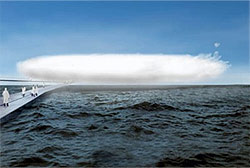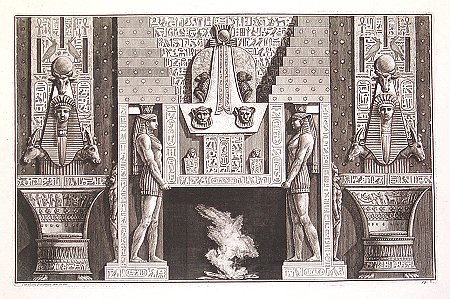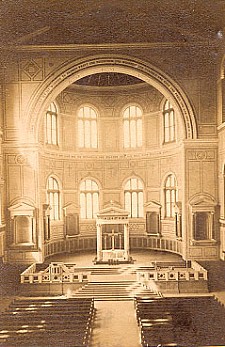2006.03.16 10:28
Complex Iconography and Contradictory Content in Architecture
Complex Iconography and Contradictory Content in Architecture is the latest addition to The Working Title Museum.
Preface to the online-perhaps-interactive edition:
Helena Augusta began "Pilgrimage, Reenactment and Tourism" at Leaving Obscurity Behind by calling Bethlehem and Jerusalem Jesus event cities, and related the history of her work there. Then she had Judas, the old Jew who told her where the True Cross was buried, present a little history. (Everyone calls him Judas because he constantly denies that that is his name.) Then she had Julian the Apostate present a history of his attempt to have the Temple of Jerusalem rebuilt. (Everyone still gets a kick out of how Helena is actually one of Julian's great grandmothers.) Then she had Ismael Raji Al-Faruqi, the last Palestinian Governor of Galilee, present a very large history, especially about the Dome of the Rock as marker of dream event.
As somewhat of a surprise ending, Helena had Catherine de Ricci reenact her stigmata and ring, and then had Louis I. Kahn reenact his burying of the New Testament in snow.
2006.03.16 13:14
Complex Iconography and Contradictory Content in Architecture
"And here we have a reenactment of a cloud as water themepark building. Note the total tourism aspect. Call it pilgrimage all bottled up."

"What's that Judas? You're denying that that is called reenactionary architecturism? Well, it even took Diller till early June 2003 to find out that Renfro interned at VSBA."
2006.03.17 09:22
Complex Iconography and Contradictory Content in Architecture
The kicky part about Helena being Julian's great grandmother is that the first wife of Julian's grandfather, Constantius I, is Julian's great grandmother Helena and then the second wife of Constantius I is Julian's grandmother Theodora. No wonder Julian apostatized.
"Hey Helena, you and Eutropia should co-author The Art of Imperial Wife and Daughter Swapping in Better Late Antiquity Than Never."
"Oh, didn't you know? We already kinda sorta did that when we interventionally inspired Thomas Mann's The Holy Sinner."
"Ah, then that explains why I saw "God's Bricklayer" reading that book while smoking in the Boys Room."
Meanwhile, like a quaestio abstrusa, the gang is looking for all the instances where Koolhaas/OMA use the Ichnographia Campi Martii as floorpaper within the presentations of some of their projects. So far there's: Schiphol S, Extension to the MoMA and CCTV.
"Hey Piranesi, does this mean anything?"
"No."
"Not even like using existing iconography to evoke some new and original architectural ideas."
"I'm sorry, but did you just forget who you're talking to?"

| |
2006.03.19 12:25
Complex Iconography and Contradictory Content in Architecture
The last Palestinian Governor of Galilee and Koolhaas are the only people mentioned so far that I have ever met or seen in person. I discussed urban planning with the Governor for about ten minutes in 1977--I at least remember he said, "The three different areas should be autonomous."--and Koolhaas heard me discuss "content" with Venturi and Scott Brown 29 September 2001.
In the recent remake of the movie Alfie, the title character says something about making sure you at least have a dating partner during the holidays between Thanksgiving and New Years. Taking the daughter of the last Governor of Galilee on a date to see Saturday Night Fever (her choice) was for sure memorable, and the 1979 New Year's party at the Governor's house (sans Governor) was a blast.
Hey, is that a blur in the Piranesi cammini?
2006.03.19 12:33
Complex Iconography and Contradictory Content in Architecture
While on the way to see the movie downtown, H. was upset because her father said Ralph Stevens called. Believe me, when a left a message with the Governor I told him I was Steve Lauf. Yes, Lauf rhymes with Ralph.
the cellardoor whore: shhh
2006.03.19 15:28
Complex Iconography and Contradictory Content in Architecture

This is only the beginning. Besides, the first five chapters are already in the works.
...the first five chapters are already in the works.
1. Herrenchiemsee
2. From Augusta Treverorum to Constaninople and back again
3. Complex Ichnography and Contradictory Contentment
4. Piranesi takes a vacation
5. Learning from Lacunae
2006.03.19 15:28
Complex Iconography and Contradictory Content in Architecture
Gosh, my memory is slightly slipping. Corrections:
I discussed urban planning with the Governor for about ten minutes in 1977--
Taking the daughter of the last Governor of Galilee on a date to see Saturday Night Fever (her choice) was for sure memorable, and the 1978 New Year's party at the Governor's house (sans Governor) was a blast.
2006.04.01 10:08
Complex Iconography and Contradictory Content in Architecture
It's strange to think that the double basilica of Augusta Treverorum [Trier] (circa 326-8 AD) was the first Christian basilica of northern Europe, and for many years the largest Christian church of northern Europe as well. Little remains of the original double basilica, but two large churches are still there side by side today.
My theory as to why there were two joined basilicas, to begin with, is that they were designed to accommodate the distinct Latin and Greek populations of Augusta Treverorum. I also theorize the double basilica of Augusta Treverorum as the primogenitor of the Romanesque. Eutropia was the 'architect'.
While the Shroud of Turin is well known, the Holy Coat of Trier is much lesser known. Perhaps you know the movie The Robe, however. "The Trier tradition affirms that this relic was sent to that city by the Empress St. Helena." If this tradition is true, Helena was already dead when the Holy Coat was brought to Augusta Treverorum. It was Eutropia who executed the translation of the relic.
The head of Helena, empress and saint, is also in one the double churches at Trier.
Did Eutropia ultimately die at Augusta Treverorum? Albeit a Syrian, as a western Roman Empress herself, she certainly was no stranger to the city. It is at least known that Constantine was at Augusta Treverorum 27 September 328 and 29 December 328 while on a campaign on the Rhine. Coincidentally, the end of 328 and the beginning of 329 is exactly when coins depicting Helena Augusta stopped being issued. It has long been my contention that the Helena coins ceased once Eutropia had died.
How come architecture historians have yet to make the very direct connection between Constantine's throne hall at Augusta Treverorum (306 AD) and the first Christian basilica of Rome (312 AD)? Perhaps it is only obvious to Eutropia, Helena and Constantine and those who know them as to where the "basilican" form of the Early Christian Architecture actually came from.
 
Aula Palatina, Trier, c.306 AD.
| |
2006.04.03 14:58
Re: Constantine and Christians
My general answer is that Helena and Eutropia were extremely influential over Constantine when it came to Christianity--Christianity was at that time pro women's rights. Constantine my have also had a great dislike of the more homosexually oriented Pagan cults--now there's a future irony.
Did Constantine see the embrace of Christianity as a way to "re-unify" the Empire?
I'd say that Constantine's main reason for presiding over the Arian Controversy was to establish himself as (still) head over "church" and state.
2006.04.03 15:54
Re: Constantine and Christians
I too thought of the Donatist controversy, (as preceding the Arian controversy), but I was more thinking of that controversy revolving around whether those Christian leader who gave up the faith under the Great Persecution should be allowed back into the Church. I was not aware (or had just forgotten) about the return-of-property issue, which I find much more provocative in that after 326 Constantine began to condemn (and seize the property of, I assume) Pagan cults with homosexual orientations.
I've always been curious if being a Roman emperor automatically meant that you were the wealthiest land owner in/of the Empire as well?
2006.04.03 16:25
Re: Constantine and Christians
I'd like to mention that Krautheimer, in Corpus Basilicum Christianum Romae, offers the possibility that the Basilica Constantiniani, today's Basilica of St. John Lateran, the first Constantinian basilica of Rome, may have been started as early as November 312. If this is indeed the case, then we have Constantine giving land and a major church building to Christians, in this case the Pope, even before the Edict of Milan.
2006.04.03 17:22
Re: Constantine and Christians
Here is the Krautheimer footnote:
Construction [of the Basilica Constantiniani] need not have taken many years. The huge Basilica Nova [another building] with its time-consuming vaulting system was built and completely decorated in four or five years; and we shall see that at St. Peter's construction and interior decoration were presumably completed in the course of six to eight years. The Lateran basilica, being smaller than St. Peter's, might well have been built and finished within five or six years. Dates given for the consecration are numerous, varying from 315 to 324, but they are never based on any sources. The Martyrologium Romanum gives November 9 as the feast day of the basilica, "Romae dedicatio Basilicae Salvatoris." However, as pointed out by Lauer, the date occurs first in the second version of the Descriptio Ecclesiae Lateranensis, 1153-1154: "Cuius dedicatio per totum orbum quinto idus novembris...celebratur..." By that time, then, the tradition was well established, but we do not know how far back it went. It is certainly older than the twelfth century, but it does not occur in the early sacramentaries and martyrologia dating from the fifth to ninth century. Is it, then, the date of a reconsecration after the rebuilding by Sergius III (904-911)? This is possible, but it is equally possible that the tradition springs from a fourth century root. We leave the question open. In any event, no year is given. However, it is curious that in the reigns of Constantine and Sylvester, November 9 falls on a Sunday--since the Middle Ages the customary day for church consecrations--only four times: 312, 318, 329, 335. The last two dates can be dispensed with: the period of construction [beginning from] 313 or 314 would be too long. However, 318 would be a very plausible date for the consecration of the church. Or should we stress the choice of the word dedicatio, rather than consecratio, by the sources? Dedicatio in Roman legal language is the act of handing over or ceding--dedere--an object, be it real estate or something else, to a deity; the act of consecratio follows, once the object has been installed or the shrine, temple or whatever, has been built. Is it possible, then, that November 9, 312, not quite two weeks after his coanuest of Rome, was the day Constantine ceded to Christ the terrain on which the basilica was to be built and made the endowment for its future maintenance, in servitio luminum?
----------
I'm not sure of the date of this text, but I vaguely remember it being before World War II. I do remember, however, that the first time I read this text was November 9, 2000.
2006.04.03 17:50
Re: Constantine and Christians
Just for reference regarding the possible beginning date of the Basilica Constantiniani, according to Timothy Barnes in The New Empire of Diocletian and Constantine, Constantine was at Rome 29 October 312 to January 313, and at Rome 21 July 315 to 27 September 315, and at Sirmium (in today's Serbia) 24 October 318 to 13 April 319. The only other time Constantine was at Rome was 18 July 326 to 3 August 326, and he never returned to Rome after that.
2006.04.04 13:56
Complex Iconography and Contradictory Content in Architecture
http://omega.cohums.ohio-state.edu/mailing_lists/LT-ANTIQ/2006/04/
and that's just yesterday's posts.
It feels like early April seven years ago.
2007.11.21 11:32
Complex Iconography and Contradictory Content in Architecture
[J. B.,
Thanks for the quick response, and 'oh well' and 'that's OK'. Don't put me down for #24. I learned something (again)--if I want to write about something or 'pick' something I'll just do, without the 'frame' of editorship (which is what I felt all along). It seems that my asking [after first being asked and declining] to be guest editor, regardless of the answer, ended the discussion evenly.
Two news items from yesterday interest me, and I'll write about them later today within a thread I started well over a year ago. It's more fitting I write today too, because it's Quondam's 11th anniversary.
Steve
ps
What I meant by "Too bad this is a private email discussion" is that I would have preferred the discussion to have been within the archinect forum. I've always felt open forums suffer when......]
Lupercale Found
Digging into Jerusalem
...about two 8th century BC events.
Ah! Romulus and Remus, real brothers metabolic. It’s said their father was a god and their mother a raped virgin. They say the father of Jesus was God and his mother an unraped virgin.
To: lt-antiq
Subject: Re: Bib. for Cyrillona’s Mariology?
Date: 2003.08.09 13:32
John,
Thank you for the Graef citation. If Graef does indeed confuse Immaculate Conception with Annunciation/Incarnation, then this is one more example where such a mistake is made within modern scholarship. I have become very intolerant of this mistake after finding it several times within contemporary architectural theory texts. I even see this presence of misinformation compounded because it implicates not only authors, but editors/review peerage as well. This mistake needs broad/public attention within the realm of scholarship simply to cease the perpetuation of its existence.
It is the Annunciation, as reported by Luke 1:26-38, where a series of events are clearly described.
1. (26) The angel Gabriel is sent by God to Nazareth. The presence of an angel already constitutes a miraculous event, a theophany.
2. (27) The angel is sent to a betrothed virgin named Mary. Here Scripture clearly states that Mary is a virgin and that she is promised in marriage to Joseph.
3. (28) In greeting, Gabriel exalts Mary; "the Lord is with thee" reiterates the theophany, thus Mary's being "full of grace" and "Blessed among women" is Divinely sanctioned.
4. (29) Mary is troubled by such a greeting, signifying her overall innocence in this situation.
5. (30) Gabriel assures Mary of her safety within the theophany taking place.
6. (31) Gabriel 'announces' to Mary that she will conceive and subsequently give birth to a boy, Jesus.
7. (32-33) Gabriel Highly exalts the nature of Mary's announced offspring, indeed to the point of infinity.
8. (34) Mary exclaims confusion at the announcement, while she herself proclaims her virginity.
9. (35) Gabriel tells Mary the Holy Spirit will come upon her, the Most High will overshadow her, and the Holy One to be born will be called the Son of God. Gabriel essentially announces the soon forthcoming of the Trinity, a complete theophany.
10. (36) Gabriel then announces the Precursor, John the Baptist.
11. (37) "for nothing shall be impossible with God."
12. (38) Mary's ultimate reply, "Behold the handmaid of the Lord; be it done to me according to thy word," is extremely important on two counts. First, it is at the moment of Mary's complicity that the Incarnation (the Word becoming flesh) occurs. (Note Gabriel efficiently departs as soon as his task is complete.) Second, without Mary's complicity, the Incarnation would have been the result of a rape, not at all unlike the sexual relationship between Mars (a divinity) and Rhea Silvia (a Vestal Virgin), another reported theophany which progenerated Rome.
After the Annunciation/Incarnation comes the Visitation, where John the Baptist, when he for the first time is in the presence of the Incarnation, takes a noticeable pre-natal leap.
The last time Jesus was at the Temple in Jerusalem he manifest a riotous disturbance of the wanton commercialism going on there. Within a week of that Jesus was labeled “King of the Jews” dead on a cross. They say half of that label was rediscovered sometime in the mid 16th century, buried behind a wall for safekeeping, within the Helena chapel of Santa Croce in Gerusalemme (Holy Cross in Jerusalem). It appears to be a true 1st century AD artifact.
Romulus's life ended in the thirty-eighth year of his reign, with a supernatural disappearance, if he was not slain by the Senate.
One day, when Romulus and all the people had gone to the Campus Martius, a sudden storm arose. The darkness became so great that the people fled in terror. When the storm was over, the Romans returned. To their surprise, however, Romulus had disappeared. The people sent for him, but none could find him. The people were amazed, and were all talking about his sudden disappearance, and wondering what could have become of their king, when one of the Senators stood up and called for silence.
After the Senator calmed the mass of people, he told the assembled Romans that he had seen Romulus being carried up into the heavens.
Ascension of Jesus
Gabriel and Mohammad’s Ascension
Julian the Apostate died in battle somewhere in Persia, and is no doubt buried in the footnotes.
2007.11.24 11:23
Complex Iconography and Contradictory Content in Architecture
"No. 5, the adjoining mansion, is La Louve (the She-Wolf), so named from the carving over the door, which represents Romulus and Remus, the founders of Rome, being suckled by their wild foster-mother. This house belonged to the Archers' Guild, and is surmounted by a gilded phoenix."
Arthur Milton, Brussels in Seven Days (1935).
It was the Saturday after Thanksgiving 1999. The Inside Density colloquium was now over, and, after dinner atop the Atomium, Charlotte Geldof offered to take me around Brussels the next day. We started at the Cathedral where Charlotte took me down to the excavations under the church--she felt sure I'd be interested after hearing me talk about reenactment, inversion and pagan Rome the days prior. Then we went to the Grand' Place. (I was intrigued by the late Horta (non Art Nouveau) building inbetween). Charlotte left me standing in the middle of the Place as she went to try to get tickets to some exhibit (which we never made it to). So I stood there and admired the Hôtel de Ville, especially all the statues over the second story windows. There was this sudden three claps, and this loosely-formed group of children near to where I was immediately stood in formation and just began singing in unison. I then looked back and forth between the statues and the children, and it was like they were all singing.
Charlotte was taking too long so I started walking toward the strikingly ornamented Guild Houses along one the Place's edges, and there they were. Soon Charlotte found me and I said, "Guess who I found?" "Who?" I nodded my head upward and she saw them too. She laughed, "You're crazy."
|